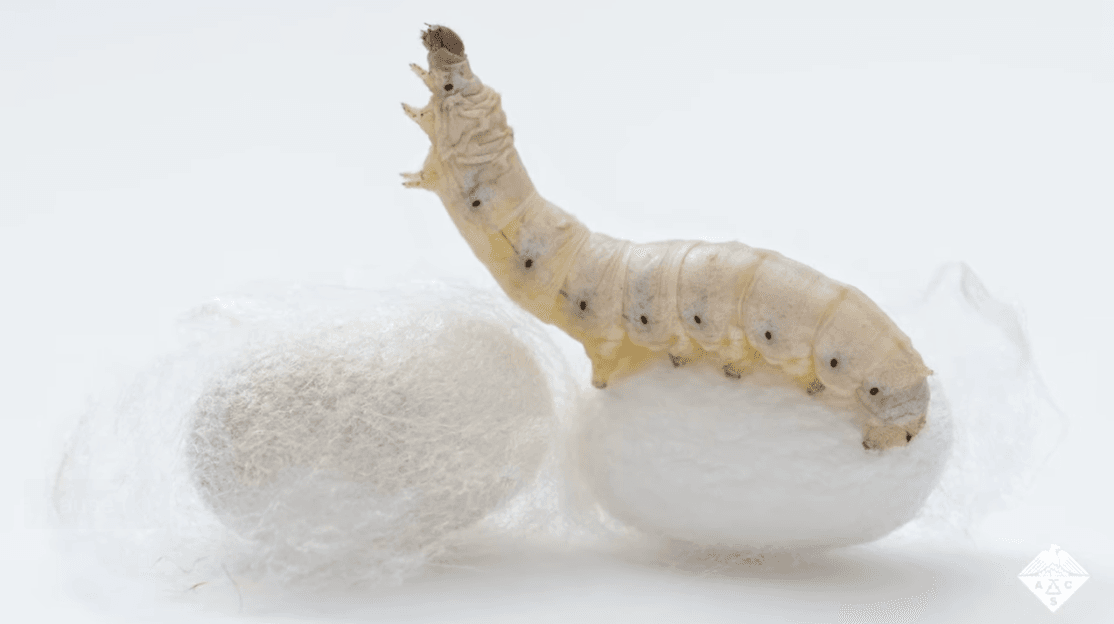For centuries, humans have used the fibers from silkworm cocoons for luxury fabric making; now, these humble caterpillars could be the inspiration for a whole new generation of biomedical applications.

Nanofibers are a promising candidate for making diverse functional materials from flexible electronics to wound dressings. But human-made nanofiber spinning methods can be convoluted and inefficient, sometimes resulting in clumpy or inconsistent fiber output.
To improve upon this, scientists have looked to the natural world for tips and tricks on creating the perfect fibers. In nature, animals such as spiders and caterpillars have evolved unique spinning processes that can create high-performance natural fibers.
The silkworm (the caterpillar of the Bombyx mori moth) spins its fibers via an adhering–pulling–adhering process. To achieve this, the silkworm first spits out silk coated with sericin to adhere to the chosen surface for its cocoon, before swinging its head up to pull the silk out of the adhesion spot—and finally pulling the silk and sticking it to the next adhesion spot.
The silkworm does not appear to need any sophisticated structure to eject the fibers or provide significant external forces; rather, it appears to be the initial adhesion on an external spot that is the key enabler for continuous spinning. This is unlike the method used by spiders, who have nozzle-like spinnerets on their abdomens to enable them to spin their webs.
Inspired by the simple approach of the silkworm, new research published in Nano Letters describes a micro-adhesion-guided (MAG) spinning technology for instant and on-demand fabrication of micro- and nanofibers. This uses microscale adhesion between the spinning fluid and its contact point. Fundamentally, the fiber formation is primarily a result of the liquid motion driven by surface tension, adhesion force, and capillary force.
The researchers explored this using two key methods. First, they used a microneedle with spinning polymer fluids fed through a microfluidic array to produce oriented, cross-linked, and all-in-one fibers. The second simplified version harnessed the natural roughness of foam to act as the micro-adhesion points—simply pulling two polymer-soaked pieces apart to instantly spin threads in the gap between them.
These results present exciting opportunities for in situ fiber-fabrication technology without the need for any specialized equipment, which could prove especially valuable for biomedical engineering. For example, the strands created with MAG spinning could be placed directly on a person’s skin to create instant, flexible bandages—and including an antibiotic in the polymer solution for the bandage fibers could open further possibilities for biomedical applications.
The researchers believe this new method will help avoid the traditional issues with current spinning techniques, bypassing the need for significant external forces to either overcome surface tension or pass through a mold—all thanks to inspiration from the tiny silkworm.
Watch the video around this research created by the ACS Science Communications team:
Explore Related Research in ACS Journals
Genetic Code Expansion of the Silkworm Bombyx mori to Functionalize Silk Fiber
Hidetoshi Teramoto, Yoshimi Amano, Fumie Iraha, Katsura Kojima, Takuhiro Ito, and Kensaku Sakamoto
DOI: 10.1021/acssynbio.7b00437
Feeding Single-Walled Carbon Nanotubes or Graphene to Silkworms for Reinforced Silk Fibers
Qi Wang, Chunya Wang, Mingchao Zhang, Muqiang Jian, and Yingying Zhang
DOI: 10.1021/acs.nanolett.6b03597
Direct Writing of Half-Meter Long CNT Based Fiber for Flexible Electronics
Sihan Huang, Chunsong Zhao, Wei Pan, Yi Cui, and Hui Wu
DOI: 10.1021/nl504150a
Polymer Template Synthesis of Flexible SiO2 Nanofibers to Upgrade Composite Electrolytes
Shujie Liu, Haoru Shan, Shuhui Xia, Jianhua Yan, Jianyong Yu, and Bin Ding
DOI: 10.1021/acsami.0c06922

